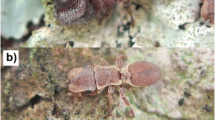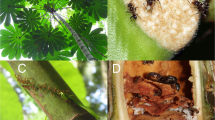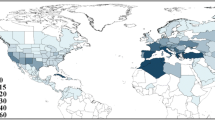Abstract
Identifying how the evolution of colony ontogeny is shaped by ecology remains one of the major challenges of sociobiology. Colony size and caste composition are two colony traits generally predicted to undergo substantial ontogenetic change, with an extended period of continuous growth followed by stability in the representation of the largest colony members and most specialized castes only at reproductive maturity. Yet these predictions are based on classic theory developed and subsequently tested using data primarily from soil-nesting ants. Here, we address the contrasting hypothesis that growth in the arboreal realm, an environment with substantially different ecological pressures, is modular via the addition of repeated nest units, and is coupled with early stability in caste production and size. We do this using full-colony collections of the turtle ant Cephalotes persimilis, spanning newly founded to reproductively mature colonies. We demonstrate predictable modular growth via an isometric scaling relationship between increases in colony size and the number of nests a colony has expanded into, and a minimum nest number for reproduction. This modular growth is further associated with specialized use of cavities with particular entrance and stem sizes. Additionally, soldiers are produced immediately by newly founded colonies occupying a single nest, and percentage soldier composition scales isometrically (19%) across all colony sizes regardless of reproductive status. This stable caste composition at the colony level is contrasted against highly variable deployment of castes across the nests of each colony. Finally, ant size increases steadily for worker and soldier castes in early colony growth and then stabilizes at reproductive maturity, but this transition happens early in colony ontogeny, at only 200 ants. These findings challenge key theoretical and empirical expectations and contribute new insights into how ecology shapes the adaptive evolution of colony ontogeny.






Similar content being viewed by others
Data availability
Data will be made available on reasonable request.
Code availability
No novel code used in study.
References
Anderson C, Franks NR (2001) Teams in animal societies. Behav Ecol 12:534–540. https://doi.org/10.1093/beheco/12.5.534
Bolton B (2020) An online catalog of the ants of the world. https://antcat.org
Calderón-Cortés N, Quesada M, Escalera-Vázquez LH (2011) Insects as stem engineers: interactions mediated by the twig-girdler Oncideres albomarginata chamela enhance arthropod diversity. PLoS ONE 6:e19083. https://doi.org/10.1371/journal.pone.0019083
Camarota F, Powell S, Melo AS, Priest G, Marquis RJ, Vasconcelos HL (2016) Co-occurrence patterns in a diverse arboreal ant community are explained more by competition than habitat requirements. Ecol Evol 6:8907–8918. https://doi.org/10.1002/ece3.2606
Camarota F, Vasconcelos HL, Marquis RJ, Powell S (2020) Revisiting ecological dominance in arboreal ants: how dominant usage of nesting resources shapes community assembly. Oecologia 194:151–163. https://doi.org/10.1007/s00442-020-04748-z
Carroll CR (1979) A comparative study of two ant faunas: the stem-nesting ant communities of Liberia, West Africa and Costa Rica, Central America. Am Nat 113:551–561. https://doi.org/10.2307/2460274?ref=no-x-route:cd8d1eef89cc76a69277d9cf2ab24cf0
de Andrade ML, Baroni Urbani C (1999) Diversity and adaptation in the ant genus Cephalotes, past and present. Stuttg Beitr Naturk Ser B 271:1–889
Debout G, Schatz B, Elias M, McKey D (2007) Polydomy in ants: what we know, what we think we know, and what remains to be done. Biol J Linn Soc 90:319–348
Dejean A, Corbara B, Roux O, Orivel J (2013) The antipredatory behaviours of Neotropical ants towards army ant raids (Hymenoptera: Formicidae). Myrmecol News 19:17–24
Dornhaus A, Powell S (2010) Foraging and defence strategies. In: Lach L, Parr CL, Abott KL (eds) Ant ecology. Oxford University Press, Oxford, pp 210–230
Dornhaus A, Powell S, Bengston S (2011) Group size and its effects on collective organization. Annu Rev Entomol 57:123–141. https://doi.org/10.1146/annurev-ento-120710-100604
Fjerdingstad EJ, Crozier RH (2006) The evolution of worker caste diversity in social insects. Am Nat 167:390–400. https://doi.org/10.1086/499545
Forti LC, Protti de Andrade AP, Camargo RDS, Caldato N, Moreira AA (2017) Discovering the giant nest architecture of grass-cutting ants, Atta capiguara (Hymenoptera, Formicidae). Insects 8:39. https://doi.org/10.3390/insects8020039
Gibson RL (1989) Soldier production in Camponotus novaeboracensis during colony growth. Insect Soc 36:28–41. https://doi.org/10.1007/BF02225878
Gordon DM (2019) The ecology of collective behavior in ants. Annu Rev Entomol 64:35–50. https://doi.org/10.1146/annurev-ento-011118-111923
Hasegawa E (1993) Nest defense and early production of the major workers in the dimorphic ant Colobopsis nipponicus (Wheeler) (Hymenoptera : Formicidae). Behav Ecol Sociobiol 33:73–77. https://doi.org/10.1007/BF00171658
Jiménez-Soto E, Philpott SM (2015) Size matters: nest colonization patterns for twig-nesting ants. Ecol Evol 5:3288–3298. https://doi.org/10.1002/ece3.1555
Kwapich CL, Tschinkel WR (2013) Demography, demand, death, and the seasonal allocation of labor in the Florida harvester ant (Pogonomyrmex badius). Behav Ecol Sociobiol 67:2011–2027. https://doi.org/10.1007/s00265-013-1611-9
LaPolla JS, Mueller UG, Seid M, Cover SP (2002) Predation by the army ant Neivamyrmex rugulosus on the fungus-growing ant Trachymyrmex arizonensis. Insect Soc 49:251–256. https://doi.org/10.1007/s00040-002-8310-2
Marting PR, Kallman NM, Wcislo WT, Pratt SC (2018) Ant-plant sociometry in the Azteca-Cecropia mutualism. Sci Rep 8:17968–18015. https://doi.org/10.1038/s41598-018-36399-9
Mikheyev AS, Tschinkel WR (2004) Nest architecture of the ant Formica pallidefulva: structure, costs and rules of excavation. Insect Soc 51:30–36. https://doi.org/10.1007/s00040-003-0703-3
Minter NJ, Franks NR, Brown KAR (2012) Morphogenesis of an extended phenotype: four-dimensional ant nest architecture. J R Soc Interface 9:586–595. https://doi.org/10.1098/rsif.2011.0377
Murdock TC, Tschinkel WR (2015) The life history and seasonal cycle of the ant, Pheidole morrisi Forel, as revealed by wax casting. Insect Soc 62:265–280. https://doi.org/10.1007/s00040-015-0403-9
Novais SMA, DaRocha WD, Calderón-Cortés N, Quesada M (2017) Wood-boring beetles promote ant nest cavities: extended effects of a twig-girdler ecosystem engineer. Basic Appl Ecol 24:53–59. https://doi.org/10.1016/j.baae.2017.09.001
Oliveira-Filho AT, Ratter J (2002) Vegetation physiognomies and woody flora of the cerrado biome. In: Oliveira PS, Marquis RJ (eds) The cerrados of Brazil: ecology and natural history of a neotropical savanna. Columbia University Press, New York, pp 91–120
Oster GF, Wilson EO (1978) Caste and ecology in the social insects. Princeton University Press, Princeton
Philpott SM, Foster PF (2005) Nest-site limitation in coffee agroecosystems: artificial nests maintain diversity of arboreal ants. Ecol Appl 15:1478–1485. https://doi.org/10.2307/4543454?ref=no-x-route:386cbcf53dd61129f8b02f1bb3f51dd1
Porter SD, Tschinkel WR (1985) Fire ant polymorphism (Hymenoptera: Formicidae): factors affecting worker size. Ann Entomol Soc Am 78:381–386. https://doi.org/10.1093/aesa/78.3.381
Porter SD, Tschinkel WR (1986) Adaptive value of nanitic workers in newly founded red imported fire ant colonies (Hymenoptera: Formicidae). Ann Entomol Soc Am 79:723–726. https://doi.org/10.1093/aesa/79.4.723
Powell S (2008) Ecological specialization and the evolution of a specialized caste in Cephalotes ants. Func Ecol 22:902–911. https://doi.org/10.1111/j.1365-2435.2008.01436.x
Powell S (2009) How ecology shapes caste evolution: linking resource use, morphology, performance and fitness in a superorganism. J Evol Biol 22:1004–1013. https://doi.org/10.1111/j.1420-9101.2009.01710.x
Powell S (2011) How much do army ants eat? On the prey intake of a neotropical top-predator. Insect Soc 58:317–324. https://doi.org/10.1007/s00040-011-0152-3
Powell S (2016) A comparative perspective on the ecology of morphological diversification in complex societies: nesting ecology and soldier evolution in the turtle ants. Behav Ecol Sociobiol 70:1075–1085. https://doi.org/10.1007/s00265-016-2080-8
Powell S, Clark E (2004) Combat between large derived societies: a subterranean army ant established as a predator of mature leaf-cutting ant colonies. Insect Soc 51:342–351. https://doi.org/10.1007/s00040-004-0752-2
Powell S, Dornhaus A (2013) Soldier-based defences dynamically track resource availability and quality in ants. Anim Behav 85:157–164. https://doi.org/10.1016/j.anbehav.2012.10.020
Powell S, Costa AN, Lopes CT, Vasconcelos HL (2011) Canopy connectivity and the availability of diverse nesting resources affect species coexistence in arboreal ants. J Anim Ecol 80:352–360. https://doi.org/10.1111/j.1365-2656.2010.01779.x
Powell S, Donaldson-Matasci M, Woodrow-Tomizuka A, Dornhaus A (2017) Context-dependent defences in turtle ants: Resource defensibility and threat level induce dynamic shifts in soldier deployment. Func Ecol 31:2287–2298. https://doi.org/10.1111/1365-2435.12926
Powell S, Price SL, Kronauer DJC (2020) Trait evolution is reversible, repeatable, and decoupled in the soldier caste of turtle ants. PNAS 117:6608–6615. https://doi.org/10.1073/pnas.1913750117
Price SL, Powell S, Kronauer DJC, Tran LAP, Pierce NE, Wayne RK (2014) Renewed diversification is associated with new ecological opportunity in the Neotropical turtle ants. J Evol Biol 27:242–258. https://doi.org/10.1111/jeb.12300
Priest G, Camarota F, Powell S, Vasconcelos HL, Marguis RJ (2021) Ecosystem engineering in the arboreal realm: Heterogeneity of wood-boring beetle cavities and their use by cavity-nesting ants. Oecologia. https://doi.org/10.1007/s00442-021-04934-7
Robinson EJ (2014) Polydomy: the organisation and adaptive function of complex nest systems in ants. Curr Opin Insect Sci 5:37–43. https://doi.org/10.1016/j.cois.2014.09.002
Robson SKA, Traniello JFA (2016) Division of labor in complex societies: a new age of conceptual expansion and integrative analysis. Behav Ecol Sociobiol 70:995–998. https://doi.org/10.1007/s00265-016-2147-6
Satoh T, Yoshida T, Koyama S, Yamagami A, Takata M, Doi H, Kurachi T, Hayashi S, Hirobe T, Hata Y (2016) Resource partitioning based on body size contributes to the species diversity of wood-boring beetles and arboreal nesting ants. Insect Conserv Divers 9:4–12. https://doi.org/10.1111/icad.12136
Schneider CA, Rasband WS, Eliceiri KW (2012) NIH Image to ImageJ: 25 years of image analysis. Nat Meth 9:671–675. https://doi.org/10.1038/nmeth.2089
Smith CR, Tschinkel WR (2006) The sociometry and sociogenesis of reproduction in the Florida harvester ant, Pogonomyrmex badius. J Insect Sci 6:32–11. https://doi.org/10.1673/2006_06_32.1
Stearns SC (1992) The evolution of life histories. Oxford University Press, Oxford
Strassmann JE, Queller DC (2010) The social organism: congresses, parties, and committees. Evolution 64:605–616. https://doi.org/10.1111/j.1558-5646.2009.00929.x
Tanaka HO, Yamane S, Itioka T (2009) Within-tree distribution of nest sites and foraging areas of ants on canopy trees in a tropical rainforest in Borneo. Popul Ecol 52:147–157. https://doi.org/10.1007/s10144-009-0172-2
Tschinkel WR (1987) Seasonal life history and nest architecture of a winter-active ant, Prenolepis imparis. Insect Soc 34:143–164. https://doi.org/10.1007/BF02224081
Tschinkel WR (1988) Colony growth and the ontogeny of worker polymorphism in the fire ant, Solenopsis invicta. Behav Ecol Sociobiol 22:103–115. https://doi.org/10.1007/BF00303545
Tschinkel WR (1991) Insect sociometry, a field in search of data. Insect Soc 38:77–82. https://doi.org/10.1007/BF01242715
Tschinkel WR (1993) Sociometry and sociogenesis of colonies of the fire ant Solenopsis invicta during one annual cycle. Ecol Monogr 64:425–457
Tschinkel WR (1999) Sociometry and sociogenesis of colonies of the harvester ant, Pogonomyrmex badius: distribution of workers, brood and seeds within the nest in relation to colony size and season. Ecol Entomol 24:222–237
Tschinkel WR (2004) The nest architecture of the Florida harvester ant Pogonomyrmex badius. J Insect Sci 4:21. https://doi.org/10.1093/jis/4.1.21
Tschinkel WR (2011) Back to basics: sociometry and sociogenesis of ant societies (Hymenoptera: Formicidae). Myrmecol News 14:49–54
Vasconcelos HL, Maravalhas JB, Feitosa RM, Pacheco R, Neves KC, Andersen AN (2017) Neotropical savanna ants show a reversed latitudinal gradient of species richness, with climatic drivers reflecting the forest origin of the fauna. J Biogeogr 16:273. https://doi.org/10.1111/jbi.13113
Walker J, Stamps J (1986) A test of optimal caste ratio theory using the ant Camponotus (Colobopsis) impressus. Ecology 67:1052–1062
Wheeler DE (1991) The developmental basis of worker caste polymorphism in ants. Am Nat 138:1218–1238. https://doi.org/10.1086/285279
Wills BD, Powell S, Rivera MD, Suarez AV (2018) Correlates and consequences of worker polymorphism in ants. Annu Rev Entomol 63:575–598. https://doi.org/10.1146/annurev-ento-020117-043357
Wilson EO (1983) Caste and division of labor in leaf-cutter ants (Hymenoptera: Formicidae: Atta) IV. Colony ontogeny of A. cephalotes. Behav Ecol Sociobiol 14:55–60. https://doi.org/10.1007/BF00366656
Wilson EO (1985) The sociogenesis of insect colonies. Science 228:1489–1495
Acknowledgements
We thank members of the Powell Lab, Matina Donaldson-Matasci, and two anonymous reviewers for valuable feedback on earlier versions of this paper. SP thanks Kleber Del Claro for access to field sites and Walter Tschinkel for instilling a great appreciation for insect sociometry data. This study was funded by an 1851 Research Fellowship from the Royal Commission for the Exhibition of 1851, U.K., and National Science Foundation grant DEB 1442256, both awarded to SP.
Funding
This study was funded by an 1851 Research Fellowship from the Royal Commission for the Exhibition of 1851, U.K. and National Science Foundation grant DEB 1442256, both awarded to S.P.
Author information
Authors and Affiliations
Corresponding author
Ethics declarations
Conflict of interest
The authors have no conflicts of interest to declare that are relevant to the content of this article.
Ethical approval
None needed.
Consent to participate
None needed.
Consent for publication
None needed.
Rights and permissions
About this article
Cite this article
Powell, S., Peretz, C. Reexamining how ecology shapes the ontogeny of colony size and caste composition in social insects: insights from turtle ants in the arboreal realm. Insect. Soc. 68, 229–243 (2021). https://doi.org/10.1007/s00040-021-00821-9
Received:
Revised:
Accepted:
Published:
Issue Date:
DOI: https://doi.org/10.1007/s00040-021-00821-9




